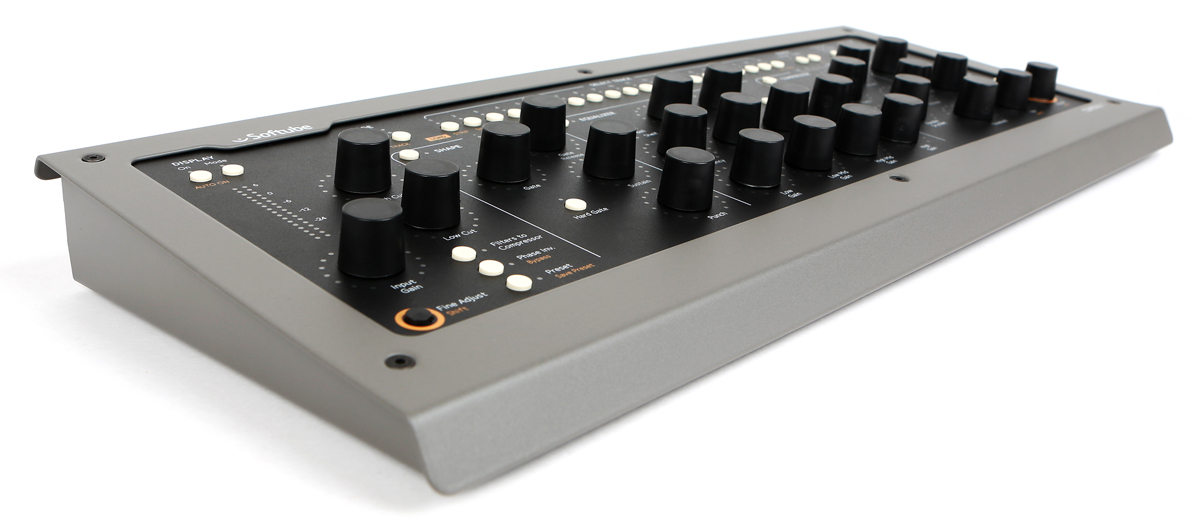5 ways that Softube’s Console 1 helps you to mix faster and better
Meet the hardware controller that will change your workflow
1. Mixing with a mouse is rubbish
A mouse is one simple controller for any number of different tasks. It’s useful because of the variety of things it can just-about-do. But because it’s so generic by design, it’s not actually very good at any of them.
You can control your mixing functions with a mouse. Equally, you can sketch a cat with a mouse in Microsoft Paint. But it’s fiddly and slow and unsatisfying, and the results are rarely triumphant.
Serious digital artists use pen-like controllers on sketchpad-like surfaces. It’s quicker, more enjoyable, and ultimately produces better results.
Console 1 is the same. It’s not a generic controller, designed for as many different tasks as possible. It’s a focused design; the fastest, most intuitive, and most enjoyable way to control your mix – gain-staging, panning, EQ, gating, transient shaping, compression, saturation.
A mouse is an amazing thing; some would say even more important to the average computer user than a Console 1. But you’re not an average computer user. You’re a mix engineer.
2. Too much choice results in bad choices
Imagine you’re cooking a meal for a group of very important people in a well-equipped, modern kitchen. You set your main dish simmering on the top-of-the-line stove, which controls temperature perfectly and predictably, and offers every imaginable feature.
Now, seasoning. You open the spice cabinet. Every flavour is there in clear glass bottles; basil, paprika, nutmeg, cinnamon, lemongrass, tamarind, saffron, thyme, curry leaves, bayleaves, powdered garlic, powdered ginger, powdered celery, cumin, cardamom, chilli flakes... and so on ad infinitum.
Naturally, you take the opportunity to experiment. A dash of this, a pinch of that. Before you know it, you’re serving an indescribable swill of nonsense to the King and Queen, wishing you’d had salt and pepper clearly laid out and labelled on top of the counter, right by the burners.
Because the workflow integrates beautifully with the DAW (your top-of-the-line modern kitchen) straight out of the box, Console 1 doesn’t in fact deny you any of the flexibility and versatility of computer-based mixing. You can still reach for the fenugreek should you wish.
But Console 1 puts the time-tested, use- them-every-mix, salt and pepper processes right where you need them: front-and-centre every time.

3. Too much choice slows you down
If you have a lot of plug-ins, you want to use them! You’ll audition 14 different models of the same analogue hardware on your barely-audible egg-shaker to find the one that suits.
Virtuous as this process may sound, time is money. In the real world a mix engineer needs a tool they can rely on for the majority of basic, functional work. This frees up time and creative energy to focus on the biggest gains at other points in the process.
Console 1’s included Solid State Logic SL 4000 E-series console emulation is reliable and versatile, and gives fast, satisfying results on the vast majority of source material. That’s why it was such a coveted workhorse in hardware, when a studio had to commit to one desk for all needs.
Of course, sometimes a specialist sound is called for, but having such a great-sounding tool as your default saves you time and allows you to be wise and discerning, and to pick the most valuable places in your mix for those touches of added personality.
4. Console 1 lets you build with character
One of the double-edged swords of working in a potentially limitless digital studio is that it’s easy to get distracted from your purpose. Whether the included SSL console, or the British Class A (sold separately), is the heart of your mix, that choice will necessarily result in a particular character, a recognisable charm, often absent from digital mixes.
True professionals know that making some rules can give a project personality. An architect decides early to build predominantly with titanium, or using 14th Century Nordic aesthetics, or whatever. Perhaps they will break their own rules - use a bit of glass for the windows - but clear, arbitrary limitations define the project and make the creative ideas cohere.
With unlimited time and resources a building could quickly become an ill-conceived mish-mash of styles, materials, and processes. So could a mix.
5. Computer mixing is a wilderness; Console 1 is ‘home’
The goal of computer development for decades has been to open horizons and widen perceived possibilities. But be honest - do you regularly use more than 20% of the functions of your DAW?
Most people use the same small set of features vastly more often than all the rest. DAW layouts try to prioritise, but nonetheless, it’s easy to get lost, peering over the next hill, or into the next canyon.
With its never-changing hardware, and super-focused on-screen display, Console 1 doesn’t end those adventures, but it puts them in a different space than the things you need every day.
It’s like a wandering community finally putting down roots by building a village. Suddenly, there’s an inside and an outside; a clear concept of ‘home’. You can bring everyday things inside, and leave the rest ‘out there’ until you want to go get them. All of a sudden, you could grow some wheat and make some bread if you wanted to.
Even creating custom channel strips, bringing plugins from Softube or UAD into the shape, EQ, or compressor sections of Console 1, the layout and visuals remain the same, and the knobs stay put and do what you expect them to, giving you structure you couldn’t dream of on the open plains of the DAW.
Just as with the very development of humankind, the endless expansion of opportunity must eventually be book-ended and defined for the far greater magnificence of well-ordered society to emerge.
Want all the hottest music and gear news, reviews, deals, features and more, direct to your inbox? Sign up here.